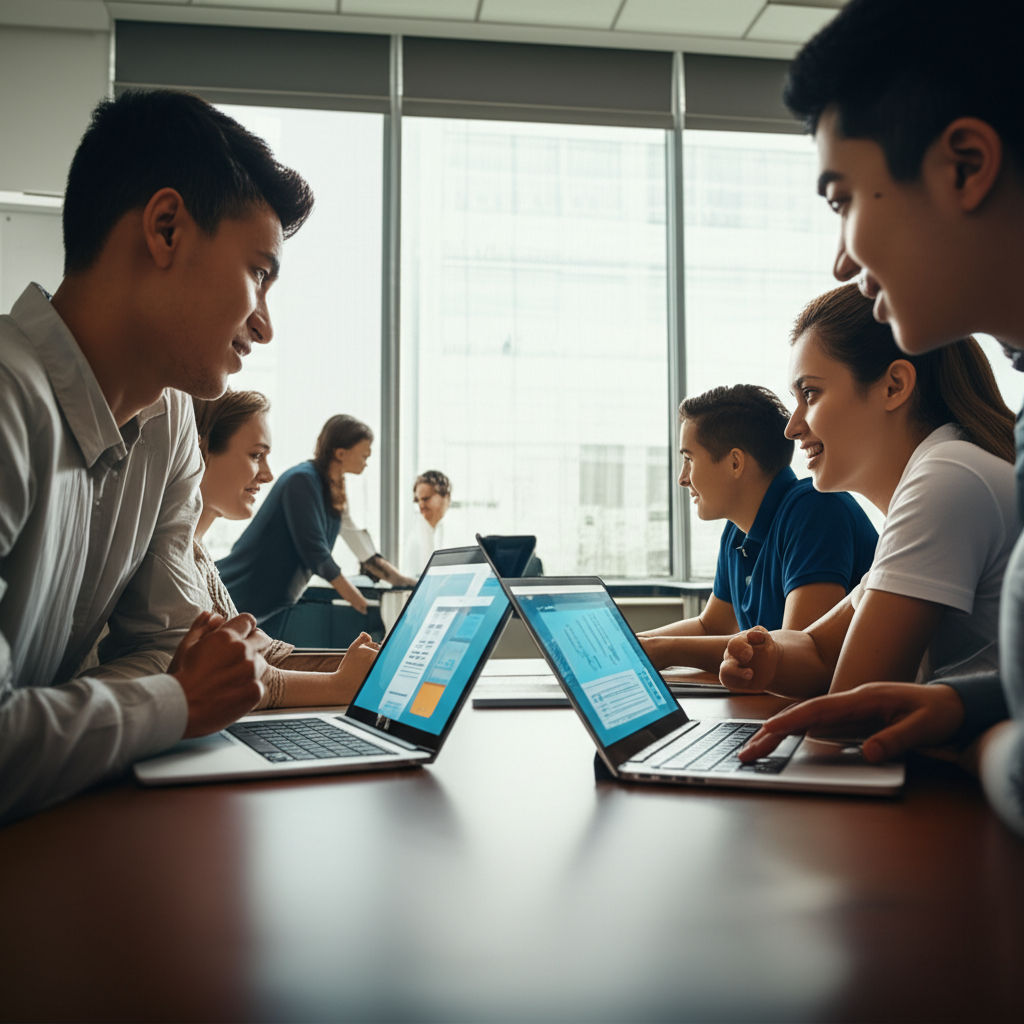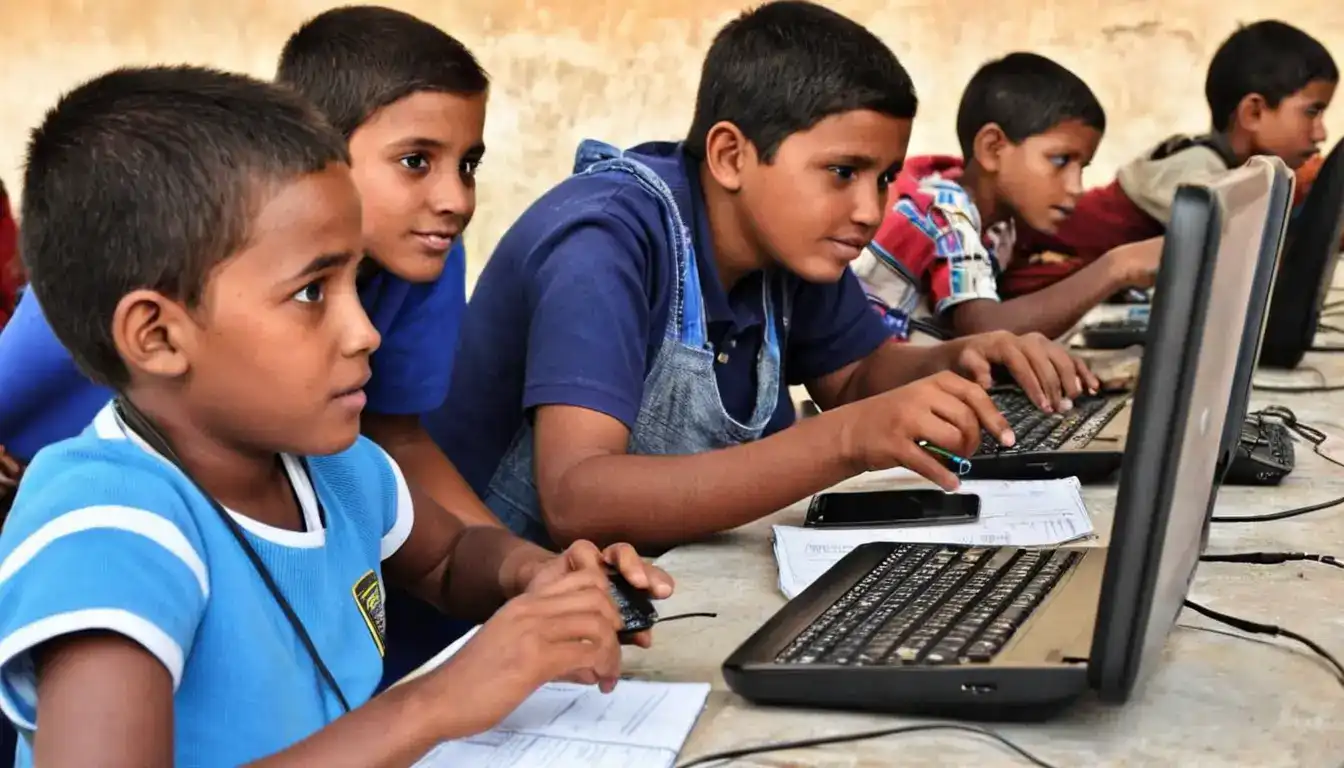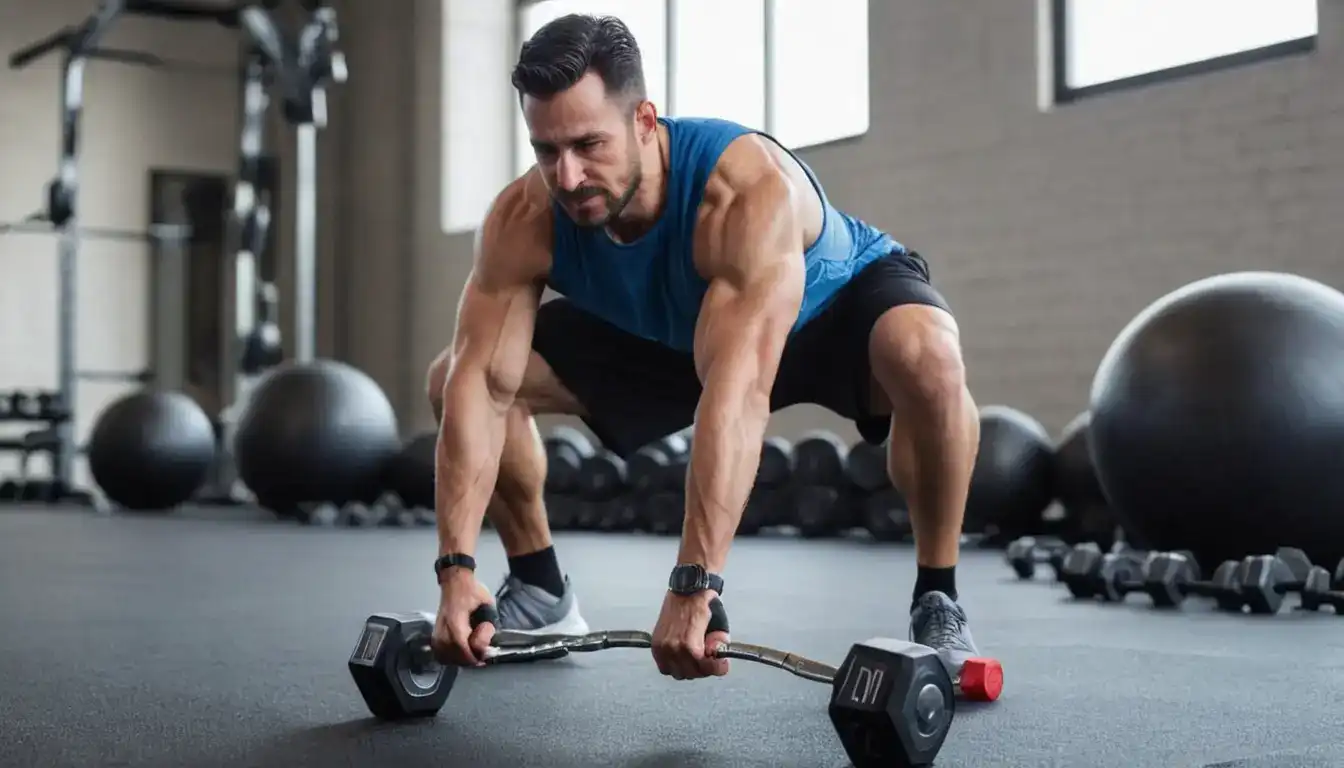Flipped Classroom: Permanent in Future Ed?
Emily Willis

Photo: Flipped Classroom: Permanent in Future Ed?
The Flipped Classroom: A Permanent Fixture in Future Education?
Remember those days in school when the teacher lectured at the front of the class, and then you went home to wrestle with homework, often alone? What if we told you there's a different way, a "flipped" way, that's transforming learning and might just be here to stay? The flipped classroom model is gaining significant traction in modern learning, offering a fresh approach to how students engage with material and how teachers guide them. But is this innovative teaching method truly a permanent education solution, or just a passing trend? Let's dive in and explore the fascinating world of flipped learning!
What Exactly is a Flipped Classroom?
At its core, a flipped classroom inverts the traditional teaching model. Instead of receiving lectures in class and doing homework at home, students get their initial exposure to new content outside of class. This often involves watching pre-recorded video lectures, reading assigned materials, or engaging with online modules. Think of it as "homework first, then classwork."
So, what happens during class time? This is where the magic truly unfolds! With the foundational knowledge already acquired, precious in-class time is dedicated to active learning, hands-on activities, discussions, group projects, and problem-solving exercises. The teacher's role shifts from being the primary "sage on the stage" delivering information to a "guide on the side," facilitating deeper understanding, providing personalized support, and addressing individual student needs. This approach aims to free up class time for activities that involve higher-order thinking.
This model isn't entirely new; similar concepts like "peer instruction" have existed for decades. However, technological advancements have made the flipped classroom more accessible and popular in recent years.
Why Are Flipped Classrooms Gaining Traction?
The rise of the flipped classroom isn't just a pedagogical fad; it's driven by several compelling benefits that resonate with the demands of modern learning and the needs of diverse students.
Personalized Learning and Self-Paced Exploration
One of the most significant advantages of a flipped classroom is its ability to facilitate personalized learning. Students can engage with the learning material at their own pace, rewatching complex parts of a lecture or reviewing readings as many times as needed. This allows students to master concepts before moving on, a key aspect of competency-based learning. This flexibility is particularly beneficial for students who might need more time to grasp certain topics or for those who can move ahead more quickly.
Enhanced Engagement and Deeper Understanding
Traditional lectures can sometimes be passive, leading to disengagement. In a flipped classroom, the in-class activities are designed to be interactive and engaging, pushing students from passive recipients to active constructors of knowledge. When students come to class prepared, they are ready to apply what they've learned, ask questions, and collaborate with peers. This active participation fosters a deeper understanding of the subject matter and encourages critical thinking and problem-solving skills. Research indicates that flipped learning can positively affect student engagement, motivation, and satisfaction.
More Meaningful Teacher-Student Interaction
By shifting content delivery outside the classroom, teachers gain valuable time during class to interact more closely with individual students or small groups. This increased student-teacher interaction allows educators to provide targeted support, clarify misconceptions in real-time, and offer immediate feedback. This individualized attention can be a game-changer for students who might otherwise struggle to keep up in a traditional lecture setting.
Flexibility and Adaptability
The flipped classroom model, especially when integrated with digital education tools, offers remarkable flexibility. It can adapt to various learning environments, from in-person to hybrid or fully online settings. The ability to access learning materials anywhere, anytime, is a huge benefit, particularly in a world that has increasingly embraced remote learning.
Addressing the Challenges: Is it a Smooth Ride?
While the benefits are clear, implementing a flipped classroom isn't without its hurdles. Like any educational innovation, it comes with its share of challenges for both educators and students.
Access to Technology and Resources
A significant concern is ensuring equitable access to technology and reliable internet connectivity for all students outside the classroom. Not every student has a laptop, tablet, or consistent internet access at home, which can create a digital divide.
- Solution: Schools and educators can address this by providing access to devices, offering offline materials, or designating specific times and spaces at school for students to access digital content. Clear guidelines on technology use and digital literacy training can also be helpful.
Teacher Training and Preparation Time
Transitioning to a flipped classroom requires teachers to shift their pedagogical approach. Creating engaging pre-class materials (like videos) and designing effective in-class activities can be time-consuming and challenging, especially initially. Teachers need training and support to adapt their teaching methods and leverage technology effectively.
- Solution: Professional development programs focused on flipped learning strategies, collaborative planning among teachers, and access to ready-made, high-quality resources can ease this burden. Utilizing educational technology tools can also help teachers create interactive content more efficiently.
Student Motivation and Preparation
One of the most frequently asked questions about flipped classrooms is how to ensure students actually complete the pre-class work. If students don't come to class prepared, the in-class activities lose their effectiveness. This requires a shift in student mindset towards more self-directed learning.
- Solution: Teachers can incentivize pre-class preparation through quizzes, brief assignments, or by clearly demonstrating how pre-class work directly connects to engaging in-class activities. Open communication with students and parents about the rationale and benefits of the flipped model is also crucial.
Flipped Classroom in Action: Real-World Examples
The flipped classroom isn't just theory; it's being successfully implemented across various disciplines and educational levels.
- STEM Subjects: Science, Technology, Engineering, and Mathematics (STEM) often benefit greatly from the flipped model. Students can watch lectures on complex theories or problem-solving techniques at home, then use class time for hands-on experiments, collaborative problem-solving sessions, and practical application, where teachers can provide immediate guidance.
- Medical Education: The flipped classroom model is gaining importance in medical education, enhancing students' understanding through active learning. Studies show it can improve clinical skills compared to online-only learning.
- Language Learning: In language classes, students might watch videos introducing new vocabulary or grammar rules before class. Class time can then be dedicated to conversational practice, role-playing, and interactive exercises, improving fluency and confidence.
- Corporate Training: Beyond traditional schooling, the flipped classroom model is also proving effective in corporate training, allowing employees to learn new skills at their own pace and apply them in collaborative, real-world scenarios during in-person sessions.
These examples highlight how the flipped classroom fosters a more dynamic and effective learning environment by maximizing in-class time for application and interaction.
The Future is Flipped? Why it Might Be Permanent.
Given its adaptability and proven benefits, the flipped classroom model is poised to become a permanent education fixture rather than a fleeting trend. Several factors contribute to this long-term potential:
- Adaptability to the Digital Age: We live in an increasingly digital world, and education must evolve with it. The flipped model naturally integrates technology, preparing students for a future where digital literacy is paramount. The COVID-19 pandemic further accelerated the adoption of such models, proving their resilience and necessity.
- Focus on 21st-Century Skills: The flipped classroom inherently promotes skills vital for the modern workforce, such as critical thinking, problem-solving, collaboration, communication, and self-directed learning. These are skills that traditional lecture-based models often struggle to cultivate effectively.
- Evolution of Pedagogy: Educational philosophy is moving towards more student-centered learning approaches. The flipped model aligns perfectly with this shift, empowering students to take ownership of their learning journey and fostering a more active and engaging educational experience.
- Integration with AI: The future of education is also seeing the potential integration of Artificial Intelligence (AI) with flipped classrooms. AI tutors could provide personalized support, create engaging content, and assess knowledge, further enhancing the at-home learning experience and preparing students for in-class activities. AI tools could also assist teachers in creating effective learning materials, reducing their workload.
While challenges remain, the continuous evolution of technology and pedagogical understanding suggests that the flipped classroom model will continue to refine and solidify its place in the landscape of future education.
Tips for Successful Flipped Learning
Whether you're a student, parent, or educator, here are some actionable tips to make the most of the flipped classroom experience:
For Students:
- Be Proactive: Watch assigned videos or read materials before class. This is your foundation!
- Take Notes Actively: Don't just passively watch. Pause, rewind, and take notes to solidify your understanding.
- Formulate Questions: As you go
Latest ✨
View Allfinding a conducive study environment to enhance focus and concentration. It provides tips on understanding your needs, exploring different study options, transforming your space, and developing focused study habits.
Emily Willis
Deflation explained: Discover why falling prices can harm the economy. Learn its causes, effects, and how to protect your finances.
Emily Willis
Demystify venture capital funding! This guide helps aspiring entrepreneurs secure VC, understand its benefits, and determine if it's right for their high-growth...
Emily Willis
sleep for physical and mental well-being, discussing the benefits of sleep such as physical restoration, brain function, emotional regulation, concentration, and reduced risk of chronic diseases. It explains the different stages of the sleep cycle and provides guidelines for how much sleep individuals of different ages need.
Emily Willis
Business
View All
June 8, 2025
Team Building Activities for WorkUnlock workplace synergy! Discover how effective team building activities boost communication, engagement, innovation, and productivity for high-performing team...
Emily Willis

August 4, 2024
The Importance of Financial Management for Small and Medium Enterprises (SMEs)emphasizes the importance of effective financial management for small and medium enterprises (SMEs) in a competitive business environment.
Emily Willis

June 9, 2025
Cloud Computing for Small BusinessUnlock growth & efficiency! Discover how cloud computing empowers small businesses with cost savings & agility in the digital age.
Emily Willis
Economy
View AllUnpack the 17 Sustainable Development Goals (SDGs): a global blueprint addressing poverty, climate change, and inequality for a sustainable future.
Read MoreUnlock the secret of price elasticity! Learn how price changes affect demand, revenue, and your everyday purchasing decisions. Essential for businesses & shoppe...
Read MoreEconomic Stimulus: Do they work? Unpack government's toolkit, from fiscal to monetary policy, and understand their true impact on your economy.
Read MoreEntertainment
View All
August 5, 2024
Music Universal Language: Connecting and Inspiring Across CulturesMusic has the power to transcend language barriers and connect people on a deep emotional level. It serves as a bridge between cultures, fostering understanding and appreciation for diversity. The universality of rhythm and melody creates a sense of unity, while the diversity of musical styles allows for exploration and creativity.
Emily Willis

August 4, 2024
Profiles of Famous Artists Who Inspire the Younger Generationthe inspirational aspects of famous artists such as Vincent van Gogh, Frida Kahlo, Pablo Picasso, Banksy, Yayoi Kusama, Jean-Michel Basquiat, Georgia O'Keeffe, Andy Warhol, Kehinde Wiley, and Ai Weiwei. It highlights their perseverance, innovation, authenticity, social commentary, mental health advocacy, and representation, among other qualities, and how these aspects continue to inspire young artists to pursue their creative dreams.
Emily Willis

August 4, 2024
The Latest Music Trends, Artists Influencing Pop Culture, and How Digital Platforms Facilitate the Distribution of Music GloballyThe music industry is constantly changing due to consumer preferences, technology, and the influence of artists. Digital platforms have revolutionized music creation, distribution, and consumption, leading to genre fusion, the rise of independent artists, and collaborative projects. Influential artists like Billie Eilish, BTS, and Taylor Swift have shaped pop culture globally. Streaming services, social media, and direct-to-fan engagement have transformed music distribution. Digital platforms also promote cultural diversity and inclusivity, expand markets and revenue, and drive technological advancements. The industry is also focusing on sustainability and ethical practices. To succeed in the future, stakeholders must embrace digital transformation and champion inclusivity.
Emily Willis
Health
View AllQuality sleep is essential for overall health and well-being, impacting physical, cognitive and emotional functioning. Lack of quality sleep can lead to a variety of health issues, including weakened immune function, heart problems, weight gain and cognitive impairment.
Emily Willis
Regular physical activity is crucial for maintaining long-term health and well-being. It has numerous benefits, including improving cardiovascular health, aiding in weight management, enhancing mental health, strengthening bones, boosting immune function, and promoting longevity.
Emily Willis
Heart disease is a leading cause of death globally, but early detection and prevention strategies can reduce its impact. This article discusses the importance of early detection, common risk factors, preventive measures, and lifestyle changes for heart health. Understanding heart disease, recognizing symptoms, and undergoing regular screenings are crucial. Common risk factors include high blood pressure, high cholesterol, diabetes, smoking, obesity, physical inactivity, and family history. Symptoms of heart disease include chest pain, shortness of breath, fatigue, irregular heartbeat, and swelling. Diagnostic tests and screenings include blood pressure measurement, cholesterol screening, blood glucose test, ECG, stress test, and imaging tests. Preventive measures include adopting a heart-healthy diet, regular physical activity, quitting smoking, managing stress, maintaining a healthy weight, and limiting alcohol consumption. Medications and treatment options may be necessary for individuals at high risk or diagnosed with heart disease.
Emily Willis
Trending 🔥
View All
2
3
4
5
6
7
8
10
Lifestyle


Sports
View AllAugust 5, 2024
Celebrating Sports Legends: Honoring Iconic Figures and Their Enduring Impact
Read MoreAugust 5, 2024
Sportsmanship in the Spotlight: Cultivating Respect, Integrity, and Ethical Behavior
Read MoreTechnology
View All
August 4, 2024
Bridging the Digital Divide: Ensuring Everyone Has Access to Technology
we can bridge this gap and create a more inclusive digital landscape.

August 4, 2024
The Rise of Edge Computing: Transforming Data Processing
Edge computing is a distributed computing model that processes data closer to its source, reducing latency, saving bandwidth, and enhancing security. It is transforming industries such as manufacturing, healthcare, retail, transportation, and energy by enabling real-time data processing and improving operational efficiency.

August 4, 2024
The Rise of Blockchain Technology: Applications Beyond Cryptocurrency
Blockchain technology, initially associated with cryptocurrencies, has expanded to have diverse applications across industries. It is a decentralized digital ledger that ensures secure, transparent, and immutable transactions. Beyond cryptocurrency, blockchain has been applied to supply chain management, healthcare, voting systems, smart contracts, digital identity verification, real estate transactions, and supply chain finance. Future trends include enhancing interoperability, addressing scalability issues, and exploring regulatory frameworks. Overall, blockchain technology has the potential to revolutionize various sectors by enhancing efficiency, security, and trust in operations.

August 4, 2024
All-Time High Cybersecurity Breach: How to Safeguard Your Company and Personal Information
threat of cybersecurity breaches in today's digital age, highlighting factors contributing to the rise in cyberattacks such as increased reliance on technology, evolving threats, remote work, and profit motive for cybercriminals.


















